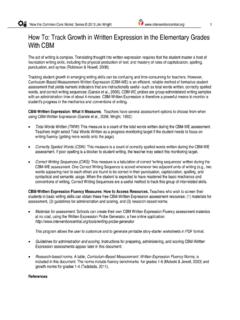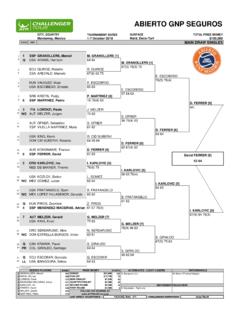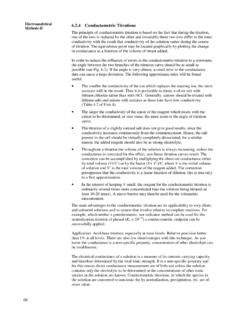Transcription of How are polls conducted? by Frank Newport, Lydia Saad ...
1 How are polls conducted? by Frank Newport, Lydia Saad, David Moore from Where America Stands, 1997 John Wiley & Sons, Inc. Public opinion polls would have less value in a democracy if the public -- the very people whose views are represented by the polls -- didn't have confidence in the results. This confidence does not come easily. The process of polling is often mysterious, particularly to those who don't see how the views of 1,000 people can represent those of hundreds of millions. Many Americans contact The Gallup Organization each year 1. to ask how our results can differ so much from their own personal impressions of what people think, 2. to learn how we go about selecting people for inclusion in our polls , and 3.
2 To find out why they have never been interviewed. The public's questions indicate a healthy dose of skepticism about polling. Their questions, however, are usually accompanied by a strong and sincere desire to find out what's going on under Gallup's hood. It turns out that the callers who reach Gallup's switchboard may be just the tip of the iceberg. Survey researchers have actually conducted public opinion polls to find out how much confidence Americans have in polls -- and have discovered an interesting problem. People generally believe the results of polls , but they do not believe in the scientific principles on which polls are based. In a recent Gallup "poll on polls ," respondents said that polls generally do a good job of forecasting elections and are accurate when measuring public opinion on other issues.
3 Yet when asked about the scientific sampling foundation on which all polls are based, Americans were skeptical. Most said that a survey of 1,500-2,000 respondents -- a larger than average sample size for national polls -- cannot represent the views of all Americans. In addition to these questions about sampling validity, the public often asks questions about the questions themselves -- that is, who decides what questions to ask the public, and how those looking at poll results can be sure that the answers reflect the public's true opinion about the issues at hand. The Sampling Issue Probability sampling is the fundamental basis for all survey research. The basic principle: a randomly selected, small percent of a population of people can represent the attitudes, opinions, or projected behavior of all of the people, if the sample is selected correctly.
4 The fundamental goal of a survey is to come up with the same results that would have been obtained had every single member of a population been interviewed. For national Gallup polls , in other words, the objective is to present the opinions of a sample of people that are exactly the same opinions that would have been obtained had it been possible to interview all adult Americans in the country. The key to reaching this goal is a fundamental principle called equal probability of selection, which states that if every member of a population has an equal probability of being selected in a sample, then that sample will be representative of the population. It's that straightforward.
5 Thus, it is Gallup's goal in selecting samples to allow every adult American an equal chance of falling into the sample. How that is done, of course, is the key to the success or failure of the process. Selecting a Random Sample The first one thousand people streaming out of a Yankees game in the Bronx clearly aren't representative of all Americans. Now consider a group compiled by selecting 1,000 people coming out of a Major League Baseball game in every state in the continental United States -- 48,000 people! We now have a much larger group -- but we are still no closer to representing the views of all Americans than we were in the Bronx. We have a lot of baseball fans, but, depending on the circumstances, these 48,000 people may not even be a good representative sample of all baseball fans in the country -- much less all Americans, baseball fans or not.
6 When setting out to conduct a national opinion poll, the first thing Gallup does is select a place where all or most Americans are equally likely to be found. That wouldn't be a shopping mall, or a grocery store, an office building, a hotel, or a baseball game. The place nearly all adult Americans are most likely to be found is in their home. So, reaching people at home is the starting place for almost all national surveys. By necessity, the earliest polls were conducted in-person, with Gallup interviewers fanning out across the country, knocking on Americans' doors. This was the standard method of interviewing for nearly fifty years, from about 1935 to the mid-1980s, and it was a demonstrably reliable method.
7 Gallup polls across the twelve presidential elections held between 1936 and 1984 were highly accurate, with the average error in Gallup's final estimate of the election being less than 3 percentage points. By 1986, a sufficient proportion of American households had at least one telephone to make telephone interviewing a viable and substantially less expensive alternative to the in-person method. And by the end of the 1980s, the vast majority of Gallup's national surveys were being conducted by telephone. Today, approximately 95% of all households have a telephone and every survey reported in this book is based on interviews conducted by telephone. Gallup proceeds with several steps in putting together its poll with the objective of letting every American household, and every American adult have an equal chance of falling into the sample.
8 First, we clearly identify and describe the population that a given poll is attempting to represent. If we were doing a poll about baseball fans on behalf of the sports page of a major newspaper, the target population might simply be all Americans aged 18 and older who say they are fans of the sport of baseball. If the poll were being conducted on behalf of Major League Baseball, however, the target audience required by the client might more specific, such as people aged twelve and older who watch at least five hours worth of Major League Baseball games on television, or in-person, each week. In the case of Gallup polls that track the election and the major political, social and economic questions of the day, the target audience is generally referred to as "national adults.
9 " Strictly speaking the target audience is all adults, aged 18 and over, living in telephone households within the continental United States. In effect, it is the civilian, non-institutionalized population. College students living on campus, armed forces personnel living on military bases, prisoners, hospital patients and others living in group institutions are not represented in Gallup's "sampling frame." Clearly these exclusions represent some diminishment in the coverage of the population, but because of the practical difficulties involved in attempting to reach the institutionalized population, it is a compromise Gallup usually needs to make. Next, we choose or design a method that will enable us to sample our target population randomly.
10 In the case of The Gallup Poll, we start with a list of all household telephone numbers in the continental United States. This complicated process really starts with a computerized list of all telephone exchanges in America, along with estimates of the number of residential households those exchanges have attached to them. The computer, using a procedure called random digit dialing (RDD), actually creates phone numbers from those exchanges, then generates telephone samples from those. In essence, this procedure creates a list of all possible household phone numbers in America and then selects a subset of numbers from that list for Gallup to call. It's important to go through this complicated procedure because estimates are that about 30%.





